Can you learn how to do remarkable things?
Can you learn the skills that will make people say: “Wauw, that’s impossible for me!”?
You might think some people are born to be remarkable.
You either have a genetic advantage or you don’t.
Lazar. Dusan. Hannibal for King have the right genes. People like Frank Medrano, Ido Portal, Al Kavadlo. Brandon Meyers has them too, and Adam Raw, and Hit Richards.
The list of extraordinary people goes on and on.
But ordinary people like you and me?
Not too long ago, I used to think I was just too much of an average Joe to even scratch the surface of what those people were doing.
Too weak. Too old. Too little. Too much of anything I could think of.
Thinking about doing remarkable stuff would make me chuckle too.
I could never do that impossible stuff!
If the same belief keeps crossing your mind. Let me tell you that your thinking is flawed.
It’s not impossible. If it were, why are so many people doing it?
They are the living proof that you can learn what they are doing. Even you can do the ‘extraordinary’.
Let me tell you how.
How To Build Up Any Move Like A Puzzle
Every move has it’s secrets.
A slow and steady path of steps, that should follow one and another.
Think about it like building a puzzle. Laying one piece at a time.
You don’t start with the entire finished puzzle, you start by laying 1 piece as perfectly as you can.
Throw away a piece and you’ll find yourself with an incomplete puzzle.
Impatiently place your pieces in an attempt to build the puzzle as fast as possible and you’ll find yourself with a different puzzle than on the cover.
Patiently place every piece with another interlocking one and you’ll find yourself building a puzzle that’s bigger than you could have ever imagined.
The puzzle of learning a new move requires you to ask yourself 3 simple questions:
- Where do I need flexibility?
- Where do I need to be strong?
- How can I use the law of gravity/levers to make this move easier or harder?
We will use these questions to make a progression for the pistol squat.
It’s an easy puzzle to solve.
The Flexibility In The Pistol Squat
There are 3 important joints involved in the pistol: The ankle, the knee and the hip.
Some external rotation of your hip. Meaning opening up your hip slightly.
Full knee flexion. Meaning having the ability to move your heel to your butt.
The issue with most people is that a pistol squat will require you to have good ankle dorsiflexion.
This means having the ability to move your knees beyond your ankles while keeping your heels on the ground.
You can cheat by wearing high shoes, but you’ll discover the hard way that you can’t do a pistol squat if you aren’t wearing them.
Your shoes are compensating for your lack of ankle flexibility.
As a result you never really addressed the issue.
So before you start your pistol squat training, you need to do a small test.
Start in a regular sitting position with your legs straight.
Place your left or right heel as close to your butt as possible.
Keep your hands straight and push them as far in front of you.
Use some momentum to roll forward on your ankle while keeping your opposite leg straight and from the ground.
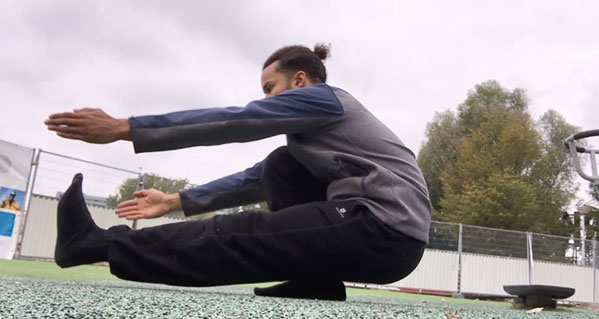
Get into the final position and try to hold yourself.
If it’s possible on both feet, you have the required dorsiflexion for the pistol squat.
If it isn’t possible, you’ll probably need to work on your dorsiflexion first.
Use this stretch to increase your ankle flexibility.
First bounce into your deepest stretch for 30 repetitions.
Then hold this position for about 60 seconds.
Repeat for 3-5 sets.
In some cases, due to bad shoes or supporting soles, the ankles might need some more force.
Either ask someone to add some pressure by pushing on your back.
Or hold some external weight in your hands. Always do this with patience and intelligence.
So let’s get started with the ‘pistol squat’.
Side To Side Squat
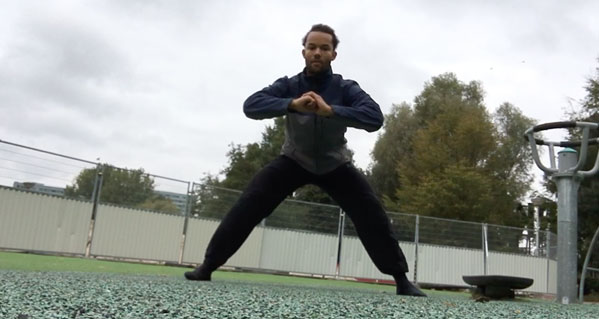
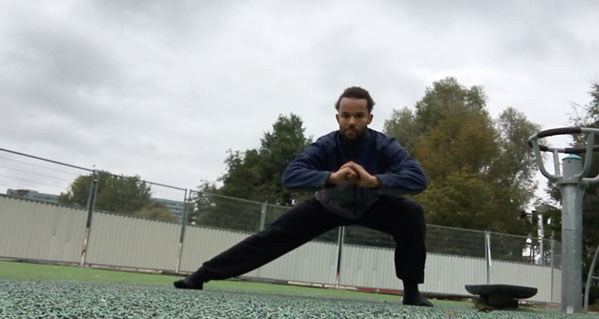
Main goal: Developing basic quad strength
Additional goal: Opening up the hips
1) Start by adopting a wide stance with your legs beyond shoulder width.
2) Shift your weight to 1 leg until you reach about a 90 degree angle with your knee.
3) Go back to the starting position and repeat for the other leg.
Mastery at 5×15 repetitions
Knee Compression Exercise
Main goal: Developing strong quads
Additional goal: Ankle and knee prehabilitation
1) Start by placing both of your knees on the ground while keeping an upright position.
2) Lift your arms up until about shoulder height while keeping them straight
3) Keep your knees together and your arms in front of you while you slowly start moving the back of your head to the ground.
4) Keep your abs and glutes contracted to ensure you keep your torso straight.
5) Keep going down until your heels touch your glutes and move back to your starting position with a straight torso.
Mastery at 5×10 repetitions
Shrimp Beginner Exercise
Main goal: Developing quad strength and balance
Additional goal: Prehabilitation of the knee joint by strengthening the VMO (The most important quad muscle for knee stability)
1) Start in an upright position with your arms in front of you and 1 leg from the ground with your foot pointing backwards.
2) Slowly move down until the non-standing knee touches the ground.
3) Make sure you keep your non-standing foot from the ground and move up again.
Mastery at 5×10 repetitions
Note: The ankle is allowed to slightly elevate to target the quads more, if you have more than enough dorsiflexion placing the ankle flat on the ground is also an option.
Pistol Squat Roll/Eccentric
Main goal: Developing quad strength and balance
Additional goal: Timing the right muscle contractions
1) Start in a sitting position with the standing foot as close to your glutes as possible and the non-standing foot completely straight.
2) Round your back and shift your weight backwards to initiate the roll.
3) Shift your weight forward and use the the standing leg to stand up as you would with a full pistol squat until you reach an upright position.
4) For the eccentric part, slowly get back to your sitting position by doing only the downward part of the pistol squat in a 5-10 second count until you can get back into the roll.
Mastery at 5×10 repetitions
Note: Depending on your strength and rate of adaptation you can start with eccentrics first before going into the full roll.
Full Pistol Squat
Main goal: Developing quad strength and balance
1) Start in an upright position with your arms in front of you and 1 leg from the ground.
2) Slowly move down until you are in the lowest possible pistol squat position.
3) Move up again until you reach your starting position and repeat.
Mastery at 5×10 repetitions
Make An Extraordinary Puzzle
No matter what the challenge, there is a way to get there.
Perhaps you don’t have the time, perhaps you don’t have the money.
But there aren’t any video game cheat codes which people can use to ‘unlock’ a new move.
They need to go through the grind, just like you.
If you want to start working on any type of move, start with the right questions and progressions.
Keep laying your extraordinary puzzle.
Piece by piece.
Until that last piece falls in place.
Beast mode ON!
Now I’d like to hear from you:
Did you like this post?
Or maybe you have a question.
Either way, make sure you get your download and leave a quick comment below right now.
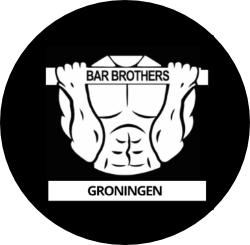

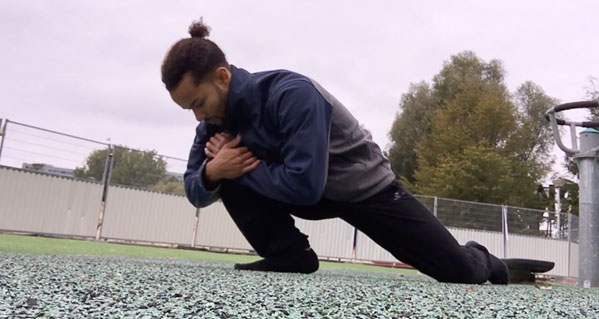
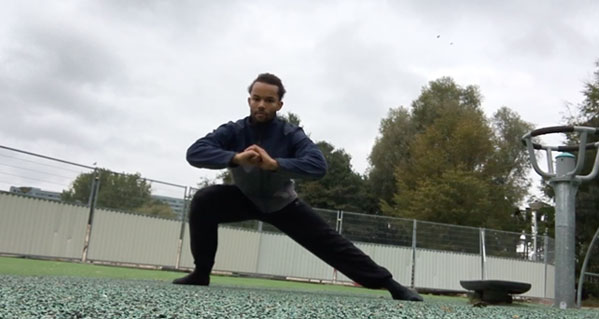
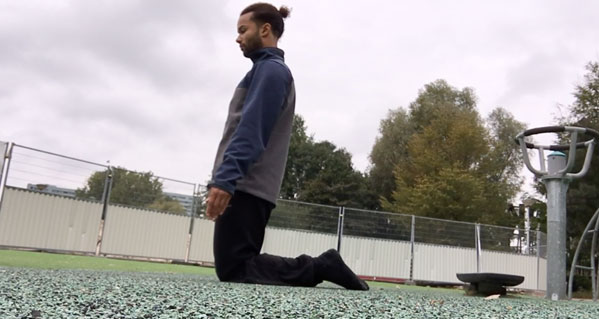
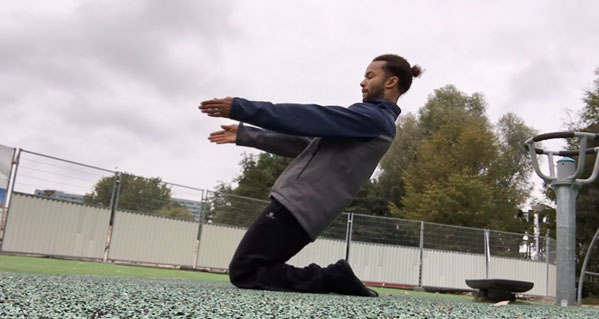
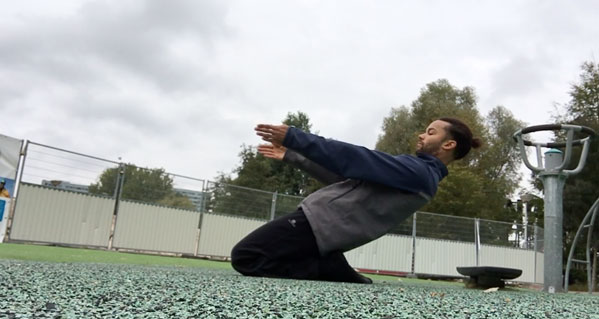
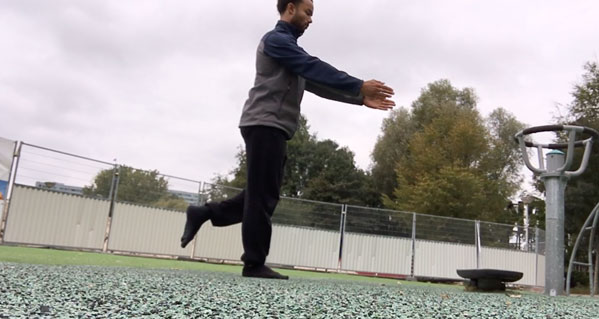
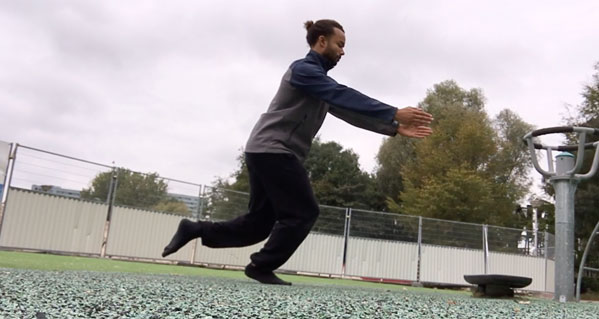
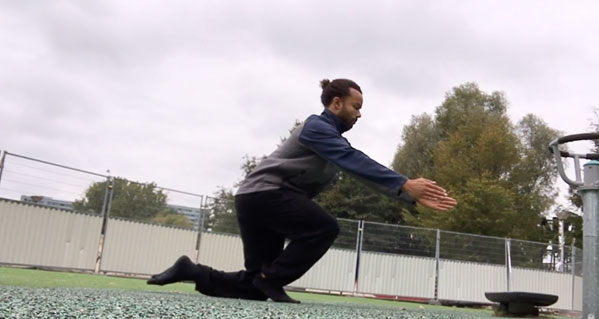
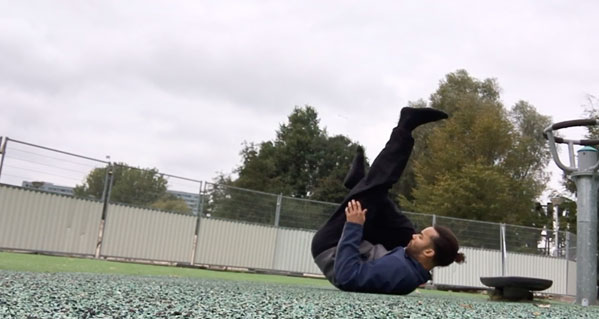
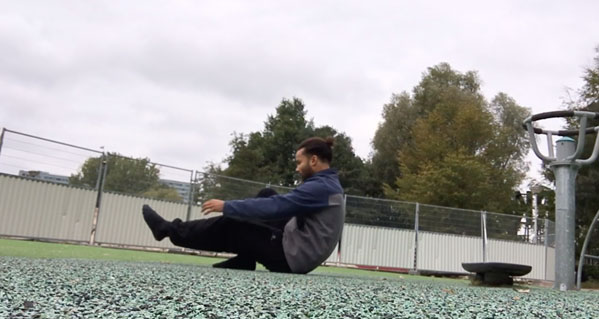
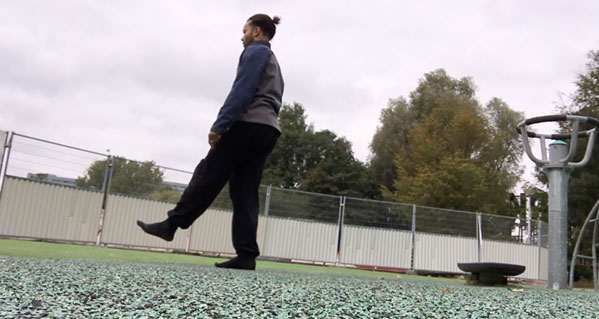
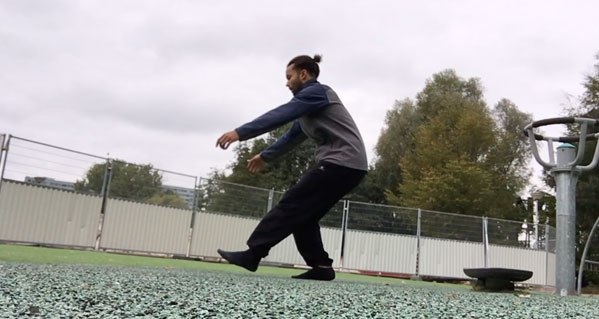
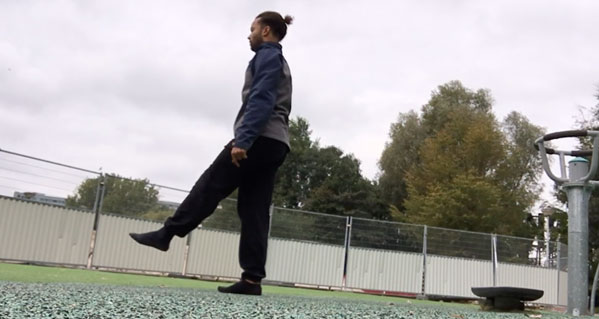
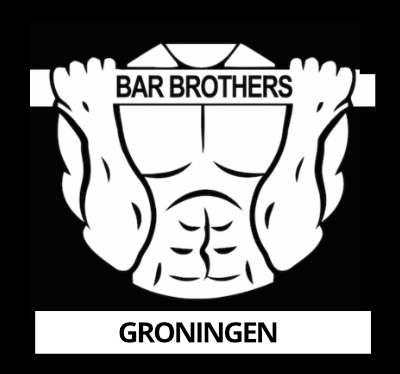
Thanks bro! This is also a awesome step by step training for a very important move greetings Lowie still beast mode On whoop whoop!
greetings Lowie still beast mode On whoop whoop!
Hey Lowie!
Always great to hear from you!
I’m proud that you are still reading my posts and are still working hard on your progress.
Keep up the good work.
Beast mode ON!
Are the side to side lunges also called lateral lunges walk?
Hey bro,
Yes they are basically the same.
Beast mode ON!
Hi,
Great post first of all.
I have the problem that my knee turns inwards and my ankle is right below my hips. Is there some missing gluteus medius strength or hip inflexibility?
What would you suggest to do?
Hey Ben,
Thanks for the comment!
Most likely adductor flexibility, which prevents you from rotating your hip outward further.
I’ll try to write a good blog on opening the hips in the future.
The side squat will already create more room, in addition I can recommend you to do some butterfly stretching and pidgeon stretching to open up those adductors, in addition to that try some soft tissue release and add some regular squatting for more glute strength. It’s never just one thing which you should do, it’s always a combination, because everything is connected.
Keep up the good work.
Beast mode ON!
Hey Rich!
I can already get 1 pistol squat each leg, but I just can’t get a single knee compression exercise done without holding into something with my arms. Should I use a rubber band to aid me so I can get full reps or there could be some other type of progression that I’m lacking?
Hey Bernardo,
Awesome!
Great question. With the knee compressions, you can apply a few progressions too.
First you can focus on the eccentric part alone, once you are with your glutes against your heels only move your torso up as you would when you are sitting on your knees normally and your glutes on your heels, from there return to your starting position.
That way you’ll make it much easier to come back up and you can focus on the eccentric part to build strength.
Another way to make it easier is by going down half way, so instead of going down all the way with the glutes to the heels, go down as far as you can and get back up again. Over time you’ll be able to get deeper, until you reach the full version.
You could also use rubber bands, the issue however is that you will get most support in the part that requires most strength. So I’m not a fan, but if it works for you and still provides you with plenty of progress, go for it.
Keep up the good work.
Beast mode ON!
As always your post is great. Thank you!
Hey Abe,
Thanks for the great comment!
I hope it will be of use to your development.
Beast mode ON!
Hey Rich. I ve seen you write about pidgeon stretching and butterfly stretching. Do you have videos or blogs about this?
Why don’t you do a complete video demonstrating and teaching a full series of Calisthenic floor exercises, like for example:
SIDE SWEEPER
KNEE-INS
MOUNTAIN CLIMBER
SPIDER PLANKS
SUPERMAN PLANKS
SIDE PLANKS
SQUAT-THRUSTS
and many more.
Hope you will put it together.
Many thanks from Scotland!
Hey Henry,
Great point, thanks for the tip.
Unfortunately doing a simple video demonstration takes a few hours of filming and another few of editing which is all unpaid work, but perhaps somewhere in the future. Thankfully there are plenty of videos routines on youtube, which you can always use :D.
Keep up the good work.
Beast mode ON!
Hey thanks for this awesomw article. However I have a problem that whenever I go down a pistol squat I just collapse because I cant hold. I think my quads are strong enough since I can do weighted pistol squats, but doing bodyweight is harder. Any tips?
Hey Steven,
Great question and thanks for your awesome comment!
It has to do with your mobility, specifically in your ankle.
When you are using weight your center of gravity is moved forward more, assuming you have the weight in front of you. The result being that you are able to hold it even with limited mobility in the ankle.
If you transition to body weight however, that extra weight moving your center of gravity forward isn’t there anymore, which results in you needing more ankle flexibility. If that range isn’t available you will indeed fall down.
So general advice: Work on your ankle mobility. You can use the exercise given here and add extra external load if you need to.
Keep up the good work.
Beast mode ON!
I’VE wrote down in my achievement book: By the end of 2017 I’ll be able to do 12 consecutive pistol squats in a perfect form.
So, I was waiting for this guide bro, and it really came! Thank you! Thank you a lot!
I’m modeling things, inspiring myself and learning the parameters of this new realm, calisthenics. And I’m also improving and training my English skills. Please, forgive any eventual errors or mistakes I probably made. Hope my message is clear as yours have been.
Hey Mauricio,
Awesome stuff! I’m looking forward to that one :D, this guide should definitely get you there.
You are more than welcome, the secret really lies in both the flexibility and strength part.
Once again, honored by your message and keep up the good work.
Beast mode ON!
Hey just to clarify. How often would you recommend working on these progression exercises? Also, if I am specifically working towards doing new movements like pistol squats and muscle ups should I skip other workouts to focus solely on these movements until I have them learned? Let me know what you think. Thanks.
Hey Craig,
It really depends on your goals and current level of strength.
Generally at least 2 times a week as a minimum, depending on your rate of recovery and adaptation.
Insert them into a circuit, so no, don’t skip other workouts. Add these progressions to your workouts ;). Customise them to your personal needs.
Beast mode ON!
Thanks for the response. When you say mastery at 5×15 reps you mean 5 sets of 15? Like, make sure you can accomplish that before attempting pistol squats?
Hey Craig,
Great question!
Yes, it will allow you to progress injury free and build in an extra buffer of strength.
Beast mode ON!
Thanks for the quick responses. much appreciated. last question I’ll ask before I learn for myself but I did want to ask. I know they say not to train when your muscles are sore, but I’m finding that my muscles are always sore. I am in really good shape, and I play a pretty high level of basketball, but I find that almost every day I have sore achy muscles and if I were to wait until days that I have no pain I would train/lift like once or twice a week. I’m particularily speaking about hanging exercises, it seems that a lot of calisthenics involve hanging from a bar but should it be totally counted out if your back is slightly sore to begin? Any thoughts on this? Thanks again.